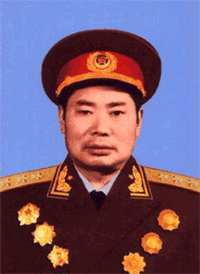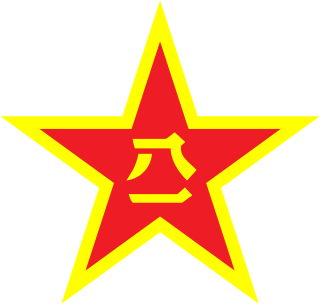Group armies or army groups or combined corps, are corps-level military formations of the People's Liberation Army Ground Force of China. Despite what the name suggests, current Group Armies are not army-level formations, but corps-sized formations commanding 12 to 14 brigades, roughly equivalent to United States Army Corps.

The Beijing Military Region was one of seven military regions for the Chinese People's Liberation Army. From the mid-1980s to 2017, it had administration of all military affairs within Beijing city, Tianjin city, Hebei province, Shanxi province, and Inner Mongolia Autonomous Region. The Region is mainly responsible for defending the People's Republic of China from Mongolia and Russia, and also protects the capital of China, and had the largest number of military personnel of any of the seven regions active from 1985 to 2017. The Region has now been disbanded and superseded by the Central Theater Command and Northern Theater Command.

Yang Dezhi was a Chinese general and politician. He was senior military officer in the North China Field Army, a veteran of the Korean War and commander in China during the Sino–Vietnamese War.
Zhengtai Campaign was a series of battles fought between the nationalists and the communists during the Chinese Civil War in the post World War II era, and resulted in the communist victory.

The 27th Group Army was a military formation of the People's Republic of China's People's Liberation Army and one of three active group armies belonging to the Beijing Military Region between 1949 and 2017. It was based in Shijiazhuang, Hebei. By 2013, the army included the 80th, 82nd, 188th, and 235th Mechanized Infantry Brigades, and the 7th Armored Brigade, plus the 12th Artillery and an AAA brigade.
The 20th Group Army is a military formation of the People's Liberation Army Ground Force, stationed in the Jinan Military Region. It consists of two manoeuvre brigades with other attached or otherwise organic units. For some time after its formation in 1949, the army consisted of three divisions.
Lüliang campaign (吕梁战役), also called Southwestern Shanxi campaign (晋西南战役), was a series of battles fought between the nationalists and the communists in Lüliang region in southwestern Shanxi during the Chinese Civil War in the post World War II era, and resulted in the communist victory.
Campaign along the Southern Section of the Datong-Puzhou Railway (同蒲路南段战役) was a campaign fought between the nationalists and the communists during the Chinese Civil War in the post-World War II era and resulted in the communist victory.
Datong-Jining Campaign (大同集宁战役) was a series of battles fought between the nationalists and the communists mainly in northern Shanxi and the surrounding regions during the Chinese Civil War in the post-World War II era. The main battlefield was centered on two cities, Datong and Jining.

Qin Jiwei was a general of the People's Republic of China, Minister of National Defense and a member of the Chinese Communist Party Politburo.

During the 1989 Tiananmen Square protests and massacre in Beijing, the Chinese People's Liberation Army (PLA) played a decisive role in enforcing martial law, using force to suppress the demonstrations in the city. The killings in Beijing continue to taint the legacies of the party elders, led by Chinese leader Deng Xiaoping, and weigh on the generation of leaders whose careers advanced as their more moderate colleagues were purged or sidelined at the time. Within China, the role of the military in 1989 remains a subject of private discussion within the ranks of the party leadership and PLA.

The 71st Group Army, Unit 31655, formerly the 12th Group Army, is a formation of the Chinese People's Liberation Army Ground Forces (PLAGF). The 71st Group Army, is one of thirteen total group armies of the PLAGF, the largest echelon of ground forces in the People's Republic of China. Assigned to the nation's Eastern Theater Command, the primary mission of the 71st Group Army is likely preparation for conflict in or about the Taiwan Strait. The unit is headquartered in Xuzhou City, Jiangsu Province.

Ye Fei was a Philippine-born Chinese military general and politician of the People's Republic of China. Born Sixto Mercado Tiongco in the Philippines to a Chinese father and a Filipino mother, he joined the Chinese Communist Party at a young age and fought many battles as a senior commander of the People's Liberation Army in the Chinese Civil War. At age 40, he was among the first PLA commanders to be awarded the rank of General by the newly established People's Republic of China and later served as Commander-in-Chief of the Chinese Navy. He also served in a number of civilian posts including Governor and Communist Party Chief of Fujian Province, and Minister of Transport.

The Central Theater Command is one of the five theater commands of the People's Liberation Army of China, and was founded on 1 February 2016. Its predecessors were the Beijing Military Region and Jinan Military Region.

The Eastern Theater Command is one of the five theater commands of the People's Liberation Army (PLA), founded 1 February 2016. It replaced the Nanjing Military Region. The command is headquartered in Nanjing.
The 28th Division was created in February 1949 under the Regulation of the Redesignations of All Organizations and Units of the Army, issued by Central Military Commission on November 1, 1948, basing on the 4th Brigade, 2nd Column of Zhongyuan Field Army.

The Third Field Army was one of the five main forces of the Communist Party's People's Liberation Army during the Chinese Civil War. It was established in early 1949. Initially known as the East China Field Army, it was formed by the New Fourth Army and the Eighth Route Army troops stationed in Shandong Province, a gradual adaptation of the expansion.
The 82nd Division was created in February 1949 under the Regulation of the Redesignations of All Organizations and Units of the Army, issued by Central Military Commission on November 1, 1948,. basing on the 28th Division, 10th Column of the Huadong Field Army. Its history can be traced to the 7th Division, Shandong Military Region, formed in August 1946.
The 83rd Division was created in February 1949 under the Regulation of the Redesignations of All Organizations and Units of the Army, issued by Central Military Commission on November 1, 1948,. basing on the 29th Division, 10th Column of the Huadong Field Army. Its history can be traced to the 11th Division, Shandong Military Region, formed in November 1946.
The 84th Division was created in February 1949 under the Regulation of the Redesignations of All Organizations and Units of the Army, issued by Central Military Commission on November 1, 1948,: basing on the 30th Division, 10th Column of the Huadong Field Army, which was just activated in January 1949.










